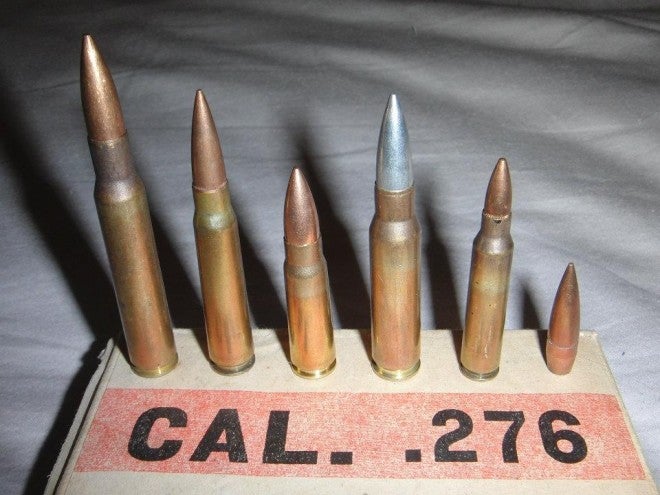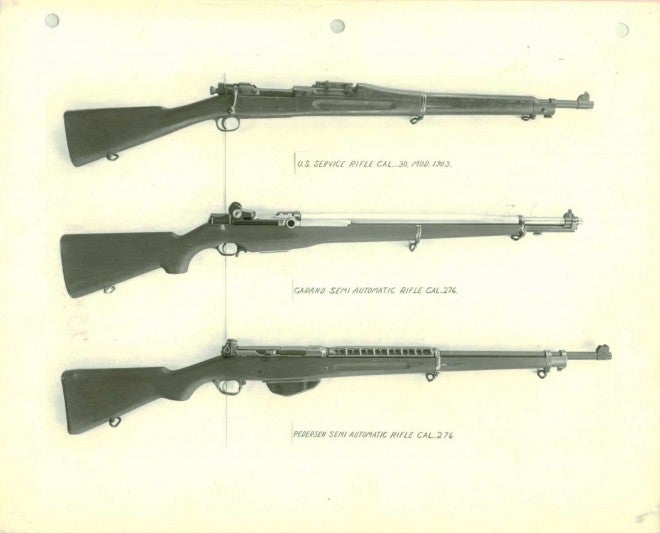This is the first part of a series of posts seeking to describe and analyze the 7.62mm Light Rifle concept promoted by the Americans, and subsequently adopted by NATO in various forms. This series will cover development from before World War II to the present day, but will focus primarily on the period from 1944-1970, which constitutes the span of time from the Light Rifle’s conception until its end in the United States with the standardization of the M16.
You can read the other parts of the series by following the links below:
- Light Rifle 1.5: A Clarification (this was written after Part I, but should be read first)
- To Challenge A Newly Won Throne: Light Rifle, Part II
- Improving The Deadliest Rifle In The World: The M1E Series (Light Rifle, Part III)
- Light Rifle, Part IV: The M1 Garand Learns To Rock And Roll
The history of the “Light Rifle” concept is just one segment of a broader history of the Ordnance branch of the US Army, and of the Springfield Armory, to both of which the concept’s fate was closely bound. One would be mistaken in thinking the story of the Light Rifle holds little relevance today, as it not only is closely related to the origin of the current structure for research, development, and procurement, but also gives many lessons on problems that structure has and could have in the future. If a better system of arms procurement is to be realized, the story of the Light Rifle is one that must be understood.
What, though, is a “light rifle”, and in what way was it meant to be used? Who conceived of it, and who insisted upon it so intently that an entire multinational organization adopted it? What were its limitations, and what were its strengths? What was the broader context into which it was conceived? Finally, why did it, despite its initial success, fall out of favor so quickly in its country of origin?
It’s my aim to answer all these questions, and more, as best I can in this series. While I hope for this series to be a distilled, readily digestible version of the story, the content within it is derived from that of a number of books written by experts on their respective topics, the most relevant of which will be listed in this series’ bibliography at the end. I would encourage my readers to take a look at the books listed there, as they provide a much more thorough understanding of the topic.
To begin, we’ll cover what exactly a light rifle is, why it has such a seemingly ill-fitting name, and some of the context in which the design was first imagined. First, it will help to re-tread briefly the earlier history of military rifles.
Shortly after the development of the repeating rifle, it became obvious that the next great step in small arms evolution would be a rifle that operated its own action, without the aid of the user. Such a rifle would not only significantly augment the rate of fire of the rifleman, but would also greatly improve his accuracy when making follow up shots (indeed it was this latter characteristic that was generally deemed most desirable). These benefits were recognized in the first decade of the 20th Century by the US Chief of Ordnance, William Crozier, who first undertook the effort of providing US troops with a “self-loading” rifle a year before the repeating M1903 was authorized for manufacture. This project, for better or worse, was throughout its life characterized by the great conservatism of the Army Ordnance Department. The earliest requirements set by the Army for selfloaders were bound within the confines of the bolt-action rifle: Not only did the Army require prospective designs to be operable both as a bolt action and as a single-shot rifle, but they even placed special emphasis on the ability to convert existing Model 1903 rifles to the new selfloading type; this last, of course, being simply too optimistic to be practical.
After the First World War, US requirements relaxed somewhat. In 1923, John D. Pedersen, a renowned firearms designer – one of the few “superstars” to ever exist in the profession – addressed the Ordnance Department with his proposal to design and build for them a .27 caliber selfloading rifle. Pedersen correctly cited that the difficulties that had been encountered in designing a successful selfloading rifle could be substantially alleviated – not to mention benefits in ammunition weight and recoil realized – if the chambering of the rifle was reduced in size from the standard .30 caliber then in service. Pedersen, who was by all accounts just as good a salesman as he was a firearms designer, was one of the few people who could successfully convince US Ordnance of a dramatic measure like this. The US Army’s selfloading rifle program would for the next decade center on Pedersen’s .276 caliber round.
It wasn’t to be, however. Pedersen, too sure of his ability to out-design his competition, would neglect his rifle during its most critical time at the very end of 1929. That year, during one of the last trials of his rifle, he left the United States and the trials behind, and traveled to the United Kingdon to sell his design to the British (who, even so early as the late 1920s, fervently wished not only for a replacement for their aging Lee-Enfield rifles, but also to adopt a common weapon with the United States). As a result, a competing design by one John Cantius Garand won the favor of the US Ordnance Department. Pedersen’s hubris was twofold: He had not only neglected to be present during this trial, which chafed the egos of Army personnel, but by his demand the contract with the Ordnance Department stipulated that he receive royalties for his design should it be produced. The Army had a great incentive to choose Garand’s design over Pedersen’s if the former were found suitable for service.
Pedersen’s vision for a .276 caliber selfloader died shortly after his rifle was rejected; without the influence of the rockstar gun designer, the keystone of the .276 concept had been removed. In a characteristically canny move, Garand had designed his rifle in both .276 and .30 caliber, and because of this the rationale for the smaller round was weakening. Though some holdouts insisted the .30 caliber was superior, many acknowledged the improvement the .276 represented; it simply wasn’t enough to justify such a logistical undertaking, and there were fears of having multiple calibers in service. In the end, conservatism won the day, and Chief of Staff Douglas MacArthur’s rejection of the .276 caliber in 1932 was merely a formalization of a decision that had already been made by the Ordnance Department: The next US rifle would be in the existing .30 caliber.

Ammunition from the author’s collection. Atop the circa 1929 .276 caliber box are from left to right: .30-06 Springfield M2 Ball, .276 Pedersen PD-42, 7.62x39mm M67, 7.62x51mm NATO DM111, 5.56x45mm M193, and a pulled .276 Pedersen PD-42 bullet, weighing 127 grains. The .276 Pedersen was the would-be replacement of the .30-06, but was aborted officially by declaration of the Army Chief of Staff in 1932. The .30-06 would later be replaced by the 7.62 NATO in 1957, which besides an overall length difference of half an inch was not a meaningful improvement. As a US rifle caliber, the 7.62 NATO was short-lived; it would be replaced in that role beginning in 1963 by the 5.56mm cartridge, and the 7.62mm M14 rifle would be finally relegated to secondary duty in 1970. After World War II, it became obvious that full power rifle cartridges were much more than what was needed, and the intermediate round – here represented by the 7.62×39 and 5.56×45 – became state of the art.
The United States adopted in 1933 the US rifle, caliber .30, M1, thus making it – for the first time in the nation’s history – the first general adopter of a totally new pattern of infantry weapon. This success would however be short-lived, as already felt in the then-fast-moving small arms world were the undercurrents of further change; the realization of the lightweight fully automatic infantry rifle was just over the horizon.
World War II would cement the future of infantry small arms; against its fast-paced, mobile warfare – at once the baptism of mechanized infantry, strategic bombing, modern combined arms, the atomic bomb, and a whole host of new war-winning technologies and methods – the bolt-action armed marksman seems almost quaint. This 19th Century weapon was by that time already being supplemented in large numbers by far cheaper automatic submachine guns firing pistol calibers, and the mass production of the German MP-44 intermediate caliber automatic rifle further doomed the bolt action as a standard weapon. The new German weapon was clearly a model for the weapon of the future. and the other destined to be made a relic of the past, as soon as the combatants found room to breathe.
In the face of this, the Light Rifle was a bold rejection of the budding assault rifle concept; at once a hyper-conservative yet extremely ambitious idea to provide the infantry with rifles which would sacrifice nothing from the full-power semiautomatic rifle, while attaining all the advantages of a lighter, fully automatic weapon engineered for the Atomic Era. It was conceived in the shadow of World War II, but seemed more a product of the 1930s than anything else. “Give us the same, but lighter and with more firepower” was the call it answered.
It’s perhaps forgivable that the nation that entered the war with the best standard-issue rifle would, once the fighting was done, desire nothing more than a somewhat improved version of it, but it still begs the question: surely there were major lessons to be learned from such an extensive and hard-fought war? At the very least, common sense would dictate that the .276 caliber – which faced weak objections except for the obstacle of convenience in the 1930s – would be for even the most conservatively minded Ordnance official a good starting point the next rifle cartridge. Against this, the Ordnance Department’s rejection of any reduced caliber round that could provide a substantial improvement over the existing .30 caliber, proves that individual common sense cannot win out over the will of an entrenched organization. Ordnance, and Springfield Armory, were most concerned with what would be easiest to produce; the natural result of this well-intentioned but hyper-conservative attitude was the Light Rifle program and its eventual progeny, the 7.62mm M14 rifle. What was good enough for GIs fighting in France and Iwo Jima was good enough for any future war, even if the fundamental requirements on which that weapon was based were nearing the half century mark in age.
The constraints initially placed on the light rifle were impossible to achieve simultaneously: A 7lb (unloaded) weapon, at once suitable for fully automatic and semi-automatic fire, firing a full-power .30 caliber round with performance not one whit lower than the M2 .30 caliber Ball round it was to replace – a rifle that while meeting that requirement would take the place of all four squad-level infantry weapons: The infantry rifle, the automatic rifle, the carbine, and the submachine gun. Simple physics and physiology would preclude the true realization of Ordnance’s “Light Rifle”, and result in a finished product that was not so light or so capable at all; in this way tremendous ambition was shackled by an orthodox view of the rifleman which had been obsolete since 1917. Until this view could be broken, the United States, or indeed NATO at large, would not have a modern, lightweight automatic infantry weapon truly suitable for the Atomic Age.
 Your Privacy Choices
Your Privacy Choices
